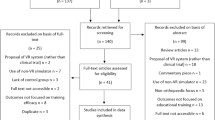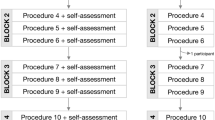Abstract
Purpose
Virtual reality (VR) training of mastoidectomy is effective in surgical training—particularly if organized as distributed practice. However, centralization of practice facilities is a barrier to implementation of distributed simulation training. Decentralized training could be a potential solution. Here, we aim to assess the feasibility, use, and barriers to decentralized VR mastoidectomy training using a freeware, high-fidelity temporal bone simulator.
Methods
In a prospective, mixed-methods study, 20 otorhinolaryngology residents were given three months of local access to a VR mastoidectomy simulator. Additionally, trainees were provided a range of learning supports for directed, self-regulated learning. Questionnaire data were collected and focus group interviews conducted. The interviews were analyzed using thematic analysis and compared with quantitative findings.
Results
Participants trained 48.5 h combined and mainly towards the end of the trial. Most participants used between two and four different learning supports. Qualitative analysis revealed five main themes regarding implementation of decentralized simulation training: convenience, time for training, ease of use, evidence for training, and testing.
Conclusions
Decentralized VR training using a freeware, high-fidelity mastoidectomy simulator is feasible but did not lead to a high training volume or truly distributed practice. Evidence for training was found motivational. Access to training, educational designs, and the role of testing are important for participant motivation and require further evaluation.


Similar content being viewed by others
References
Andersen SAW, Foghsgaard S, Konge L et al (2016) The effect of self-directed virtual reality simulation on dissection training performance in mastoidectomy. Laryngoscope 126:1883–1888. https://doi.org/10.1002/lary.25710
Lee TD, Genovese ED (1988) Distribution of practice in motor skill acquisition: learning and performance effects reconsidered. Res Q Exerc Sport 59:277–287. https://doi.org/10.1080/02701367.1988.10609373
Malekzadeh S, Deutsch ES, Malloy KM (2014) Simulation-based otorhinolaryngology emergencies boot camp: part 2: special skills using task trainers. Laryngoscope 124:1566–1569. https://doi.org/10.1002/lary.24571
Andersen SAW, Mikkelsen PT, Konge L et al (2016) Cognitive load in distributed and massed practice in virtual reality mastoidectomy simulation. Laryngoscope 126:E74–E79. https://doi.org/10.1002/lary.25449
Andersen SAW, Foghsgaard S, Cayé-Thomasen P, Sørensen MS (2018) The effect of a distributed virtual reality simulation training program on dissection mastoidectomy performance. Otol Neurotol 39:1277–1284. https://insights.ovid.com/crossref?an=00129492-201812000-00029
Sørensen MS, Mosegaard J, Trier P (2009) The visible ear simulator. Otol Neurotol 30:484–487. https://insights.ovid.com/crossref?an=00129492-200906000-00009
Fjørtoft K, Konge L, Gögenur I, Thinggaard E (2018) The Implementation gap in laparoscopic simulation training. Scand J Surg 108:145749691879820. https://doi.org/10.1177/1457496918798201
Frithioff A, Sørensen MS, Andersen SAW (2018) European status on temporal bone training: a questionnaire study. Eur Arch Oto-Rhino-Laryngol 275:357–363. https://link.springer.com/article/10.1007%2Fs00405-017-4824-0
Brydges R, Nair P, Ma I et al (2012) Directed self-regulated learning versus instructor-regulated learning in simulation training. Med Educ 46:648–656. https://link.springer.com/article/10.1007%2Fs00405-017-4824-0
Andersen SAW, Cayé-Thomasen P, Sørensen MS (2015) Mastoidectomy performance assessment of virtual simulation training using final-product analysis. Laryngoscope 125:431–435. https://doi.org/10.1002/lary.24838
Andersen SAW, Sørensen MS (2017) Visible Ear Simulator instructional videos. https://www.youtube.com/channel/UCYiItwv6e4EaILWYEGU_tMw/videos. Accessed 10 Jan 2019
Mikkelsen PT, Sørensen MS, Andersen SAW (2017) Visible ear simulator dissection manual v. 3.2. https://ves.alexandra.dk/. Accessed 10 Jan 2019
Sørensen MS, Mikkelsen PT, Andersen SAW visible ear simulator download page. https://ves.alexandra.dk/forums/ves3-ready. Accessed 10 Jan 2019
Wang H, Merchant SN, Sorensen MS (2007) A downloadable three-dimensional virtual model of the visible ear. ORL 69:63–67. https://www.karger.com/Article/Abstract/97369
Sørensen MS, Dobrzeniecki AB, Larsen P et al (2002) The visible ear: a digital image library of the temporal bone. ORL 64:378–381. https://www.karger.com/Article/Abstract/66089
Shannon SE, Hsieh H-F (2005) Three approaches to qualitative content analysis. Qual Health Res. 15(9):1277–1288. https://doi.org/10.1177/1049732305276687
Tong A, Sainsbury P, Craig J (2007) Consolidated criteria for reporting qualitative research (COREQ): a 32- item checklist for interviews and focus group. Int J Qual Heal Care 19:349–357. https://doi.org/10.1093/intqhc/mzm042
Bamford R, Langdon L, Rodd CA et al (2018) Core trainee boot camp-A method for improving technical and non-technical skills of novice surgical trainees: a before and after study. Int J Surg 57:60–65. https://www.ncbi.nlm.nih.gov/pubmed/29653248
Andersen SAW, Konge L, Cayé-Thomasen P, Sørensen MS (2015) Learning curves of virtual mastoidectomy in distributed and massed practice. JAMA Otolaryngol Head Neck Surg 141:913–918. https://www.ncbi.nlm.nih.gov/pubmed/26153783
Seabrook R, Brown GDA, Solity JE (2005) Distributed and massed practice: from laboratory to classroom. Appl Cogn Psychol 19:107–122. https://doi.org/10.1002/acp.1066
Kahol K, Leyba MJ, Deka M et al (2008) Effect of fatigue on psychomotor and cognitive skills. Am J Surg 195:195–204. https://www.ncbi.nlm.nih.gov/pubmed/18194679
Fletcher JD, Wind AP (2013) Cost considerations in using simulations for medical training. Mil Med 178:37–46. https://doi.org/10.7205/MILMED-D-13-00258
Maloney S, Haines T (2016) Issues of cost-benefit and cost-effectiveness for simulation in health professions education. Adv Simul 1:13. https://doi.org/10.1186/s41077-016-0020-3
Harvey LFB, King L, Hur H-C (2013) Challenges associated with a self-contained simulation curriculum using a home laparoscopic skills trainer. J Minim Invasive Gynecol 20:S130–S131. https://doi.org/10.1016/j.jmig.2013.08.450
Kromann CB, Jensen ML, Ringsted C (2009) The effect of testing on skills learning. Med Educ 43:21–27. https://doi.org/10.1111/j.1365-2923.2008.03245.x
Thinggaard E, Konge L, Bjerrum F et al (2017) Take-home training in a simulation-based laparoscopy course. Surg Endosc Other Interv Tech 31:1738–1745. https://doi.org/10.1007/s00464-016-5166-5
Issenberg SB, McGaghie WC, Petrusa ER et al (2005) Features and uses of high-fidelity medical simulations that lead to effective learning: a BEME systematic review. Med Teach 27:10–28. https://doi.org/10.1080/01421590500046924
Cook DA, Brydges R, Zendejas B et al (2013) Mastery learning for health professionals using technology-enhanced simulation: a systematic review and meta-analysis. Acad Med 88:1178–1186. https://www.ncbi.nlm.nih.gov/pubmed/23807104
Chang L, Petros J, Hess DT et al (2007) Integrating simulation into a surgical residency program: is voluntary participation effective? Surg Endosc Other Interv Tech 21:418–421. https://doi.org/10.1007/s00464-006-9051-5
Acknowledgements
The authors want to thank computer scientist Peter Trier, The Alexandra Institute for developing the simulation software, and professor Per Cayé-Thomasen and Dr. Martin Nue Møller for their assistance with implementation of the Visible Ear Simulator.
Funding
The Oticon Foundation and Med-El supported the development of the Visible Ear Simulator software. Funding bodies were not involved in the conception, execution, interpretation, or publication of the study.
Author information
Authors and Affiliations
Corresponding author
Ethics declarations
Conflict of interest
The authors have no other funding or conflicts of interest to disclose.
Additional information
Publisher's Note
Springer Nature remains neutral with regard to jurisdictional claims in published maps and institutional affiliations.
Rights and permissions
About this article
Cite this article
Frendø, M., Thingaard, E., Konge, L. et al. Decentralized virtual reality mastoidectomy simulation training: a prospective, mixed-methods study. Eur Arch Otorhinolaryngol 276, 2783–2789 (2019). https://doi.org/10.1007/s00405-019-05572-9
Received:
Accepted:
Published:
Issue Date:
DOI: https://doi.org/10.1007/s00405-019-05572-9




